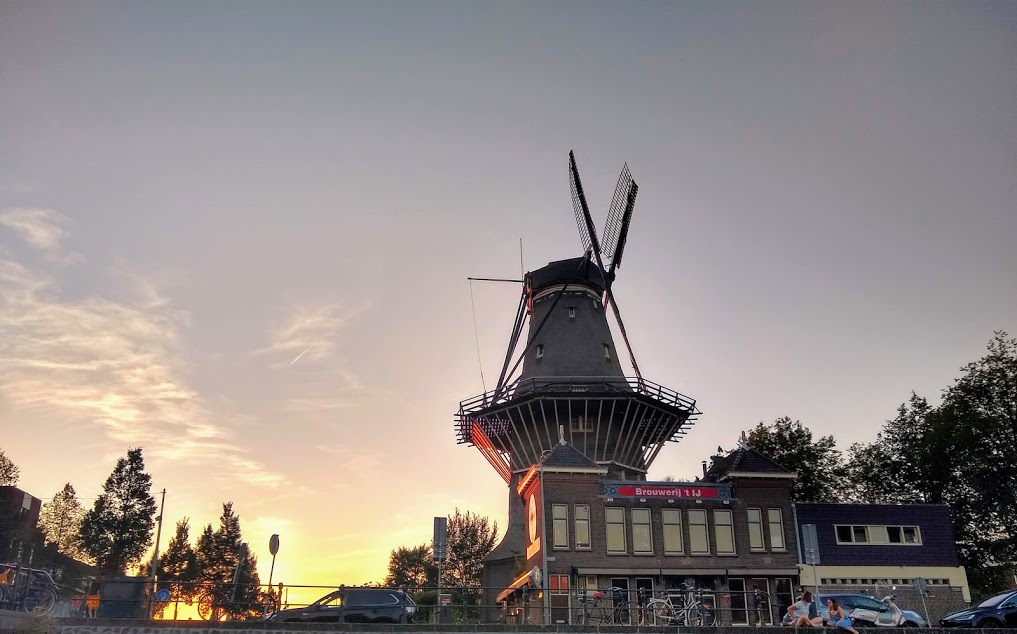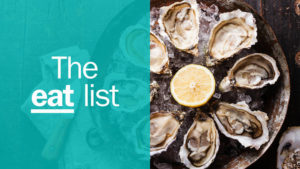
Wilde Zwijnen
This comfortable restaurant in Amsterdam East has staying power in a neighbourhood that’s been changing at breakneck speed. An early adopter of Modern Dutch cuisine, which champions local ingredients and humble vegetables, Wild Zwijnen serves four- or five-course seasonal menus in a welcoming room where guests who book ahead (always a good idea) will find their names written in chalk on their rustic wooden tables. Their next-door sister venue, Eetbar, offers more casual à la carte options and a delightful long bar. Standout dishes include the oft-changing ravioli and anything featuring Jerusalem artichoke.
Javaplein 25, Indische Buurt
wildezwijnenwinkel.nl
BAK Restaurant
Housed in the top floor of a warehouse in Amsterdam’s old timber port, BAK started out in 2013 as a pop-up passion project for the chef known as Benny Blisto (yep, he’s so famous he has a stage name) along with sommelier Alessandro da Fies and their partner Piet Sanders. It’s since matured into a top-notch fine-dining restaurant with a daily changing chef’s menu, featuring ultra-local vegetables, fish, and accents of wild game. The award-winning wine cellar features more than 500 bottles from Italy and France, with perfect pairings for each dish. The coveted window tables have panoramic waterfront views, but you’ll enjoy your meal here no matter where you sit.
Van Diemenstraat 408, Houthavens
bakrestaurant.nl
Choux
The bright red exterior, polished concrete floors and gleaming tiled walls set the stage for a stylish meal at this trendy vegetarian-friendly restaurant tucked behind Centraal Station. The three- to five-course menus feature surprising plant-based ingredients – think wild rose pickle or toasted hay – but these flavours are no gimmick in the hands of chef Merijn van Berlo. The menu lists the four main components of each dish without elaboration (a recent example: ‘pea, redcurrant, yogurt, nasturtium’), and the chef brings them to life in unexpected ways. The camera often gets the first bite at Choux, as it’s hard to resist snapping these painterly dishes.
De Ruijterkade 128, Centrum
choux.nl
Cafe Rijsel
Rijsel’s airy space and schoolroom chairs offer no hint of the deeply comforting French and Flemish richness you’ll find on the menu. When you’re in the mood for rotisserie chicken or côte de boeuf, this is the place to be. Fancy a fine French wine to elevate your meal? There are dozens of options served by the glass and an extensive bottle list that’s regularly updated. This is simple, always satisfying food with friendly service and reasonable prices. The only challenge? It’s so popular that getting a table can be tricky. Book ahead to ensure you don’t go hungry.
Marcusstraat 52, Weesperzijde
rijsel.com
De Kas
Opened in 2001, De Kas was at the forefront of the farm-to-table movement. The restaurant itself is housed in a 1920s greenhouse that features an extensive indoor growing area, supplemented by a large garden outside. It doesn’t get more local than the grown-on-site ingredients that shine in dishes like tomatoes with lemon sorbet and cucumber flowers, which you can sample in weekly changing set menus. Vegetables are the stars of the show here, and the meat-free menus are tasty enough for carnivores to savour, but there are also options that include meat and fish for those who won’t dare go a night without.
Kamerlingh Onneslaan 3, Watergrafsmeer
restaurantdekas.com
Foer
If you know the Dutch spelling of ‘forage’ is foerageren, then you can probably guess what this lovely restaurant is famous for. Yes, a large portion of the ingredients here are foraged, and the rest are supplied from local farms. Bi-monthly changing five- or seven-course menus are served either entirely without meat or with a couple of carnivorous options, and feature plenty of house-fermented ingredients like miso, sauerkraut and pickled fruits. Wood-fire cooking is embraced here, too, with an open kitchen serving as the focal point of the dining room. This is a top-spot for non-drinkers: while excellent wine pairings are available, there’s also a low- or no-alcohol option with house-made juices, kombucha, kefir, and kvass (a traditional Slavic fermented bev).
Cruquiusweg 9, Oostelijke Eilanden
foeramsterdam.nl
Restaurant Blauw
The Dutch colonial presence in Indonesia spawned some tasty fusion dishes. Take rijsttafel (literally, ‘rice table’ in Dutch), a seemingly endless sharable meal featuring small servings of spicy and savoury satay, meat, fish, and vegetable dishes and, of course, rice. In Blauw’s modern, high-ceilinged dining room, trendy meets traditional as chef Titi Waber uses techniques learned from her grandmother to make beautifully presented rijsttafels and à la carte dishes like gulai domba (braised lamb curry) and ayam pop gulai padang (marinated chicken leg). Rijsttafels require a minimum of two guests, and unless you absolutely cannot stand to share, they’re the way to go.
Amstelveenseweg 158-160, Oud-Zuid
restaurantblauw.nl
Dignita Hoftuin
For breakfast or (all-day) brunch, you can’t beat Dignita Hoftuin, hidden in a charming garden behind the Hermitage museum. Standout dishes include the ‘Benny Boy’ benedict – choose bacon, salmon or avocado – served with apple cider hollandaise and crispy hash browns, or the zucchini and chickpea fritters with halloumi. The dining room features floor-to-ceiling glass windows, so you feel you’re in the garden whether you dine inside or out. And the karma here is excellent: Dignita Hoftuin (and its sister locations in Vondelpark and Westerpark) provide apprenticeship opportunities for victims of human trafficking.
Nieuwe Herengracht 18a, Weesperbuurt
eatwelldogood.nl
Virtù
This darling Italian restaurant on the Czaar Peter shopping street is run by a trio of young Italians who have made Amsterdam their home. They’ve poured their love for top-notch food and wine into this place, and it’s evident from the moment you arrive in their tiny dining room (or settle into their mini-terrace on the pavement out front) that they’ll treat you with care. The house-made pastas here are reliably excellent (think cannelloni with mint, potatoes, ricotta, and caprino cheese), but the showstoppers are the little touches – like a chicken liver pâté bonbon amuse-bouche, based on a classic Tuscan recipe and offered in between courses.
Czaar Peterstraat 106, Czaar Peterbuurt
virtu.amsterdam
Oedipus Brewing Taproom
Sometimes you just want a really good beer and a really good burger. When the urge hits, Oedipus Brewing Taproom in Amsterdam Noord is the place to go. The colourful warehouse is the HQ for this craft beer brand, started by four buddies who wanted to experiment with flavours not often found in Dutch beers. Their best-known brew is the ‘Mannenliefde’ – a saison with lemongrass and Szechuan pepper – but there are 11 staple beers to choose from. Roving burger-makers The Beef Chief have their own stall at the Taproom to serve up some of the city’s best patties and buns, from beef to pork belly and vegetarian options like halloumi or shitake.
Gedempt Hamerkanaal 85, Noord
oedipus.com
Foodhallen
Launched in 2014 as the Netherlands’ first food hall, Foodhallen is still undoubtedly one of the best places to have a meal in Amsterdam, bringing together 21 stands serving up everything from dim sum to tacos and Dutch meatballs. Housed in a former tram depot, this is a great spot to grab a table no matter what you want to eat (or drink: there are four bars to choose from, too). If you’ve got commitment issues, you could easily make a day of tasting your way around the vast industrial space. Just don’t forget where you left your friends – when we say it’s vast, we mean it.
Bellamyplein 51, Oud-West
foodhallen.nl
Moeders
Old-school Dutch comfort food stands in stark contrast to the fresher leanings of modern Dutch cuisines – think cabbage galore, potatoes and meat. These days, you’re more likely to find traditional fodder in home kitchens than in restaurants, but Moeders is a noteworthy exception. The mishmash aesthetic is a collaborative effort: on opening day back in 1990, every guest was asked to bring their own dinnerware, and the pieces gifted by punters are still in use today. If you don’t speak Dutch, you’ll be able to clock what moeders means relatively quickly once you spot the photos of guests’ mothers plastering every inch of the walls – even in the loo. To sample a collection of Dutch classics, order the ‘Dutch Ricedish’ which, strangely, involves no rice but does feature plenty of hearty veg, meat and spuds.
Rozengracht 251, Jordaan
moeders.com
Alex + Pinard
Small but perfect, this spot has the wine bar trifecta: great food, friendly staff and an extensive selection of grapes by the bottle or the glass. The menu leans towards simple and Italian – try the signature dish of pappardelle and pork ragù – but the seasonal selection also features dishes like spicy fried chicken or sweet potato and oyster mushroom tacos. It sounds like a strange mix, but somehow it all works. If you can’t decide, just ask for the meat or vegetarian dish of the day and a glass of the house wine – you won’t be disappointed.
Dapperstraat 10, Dapperbuurt
alexpinard.nl
Mediamatic ETEN
Grab your closest confidantes for a fresh and colourful vegan four-course meal in a waterfront greenhouse built for two or four. Your bubble is only popped in Mediamatic ETEN’s private glass rooms when a server comes with the next dish, making this an excellent choice for a more – ahem – intimate engagement. This could all feel gimmicky – and in truth, it is a tad – but the food holds its own, and the concept makes for an undeniably fun night out. Tickets for the ‘Serres Séparées’ (as they’re called) are sold in advance at €95 for two for the set menu, with an optional wine or non-alcoholic drink pairing available when you arrive. But if this all just sounds a bit much, you can opt for a run-of-the-mill reservation in the dining room.
Dijkspark 6a, Oosterdok
mediamatic.net
Wils
Wils is an incendiary meeting of minds between chefs Erwin Oudijk, Friso van Amerongen, and Joris Bijdendijk (previously of Michelin-starred RIJKS). Wood fire is the primary cooking method here, and it’s on full display in fire pits, woodstoves, and bread ovens in an open kitchen that runs the length of the room. Dishes on the six-course tasting menu feature creative flavour combinations like squash with almonds, sage and orange, or quail with red chicory, apple and onion, all with the characteristic smoky flavour that comes from cooking over wood flame. Much of the seating runs along work counters where the chefs busy themselves, giving diners a front-row seat to this exciting kitchen theatre.
Stadionplein 26, Stadionbuurt
restaurantwils.nl



